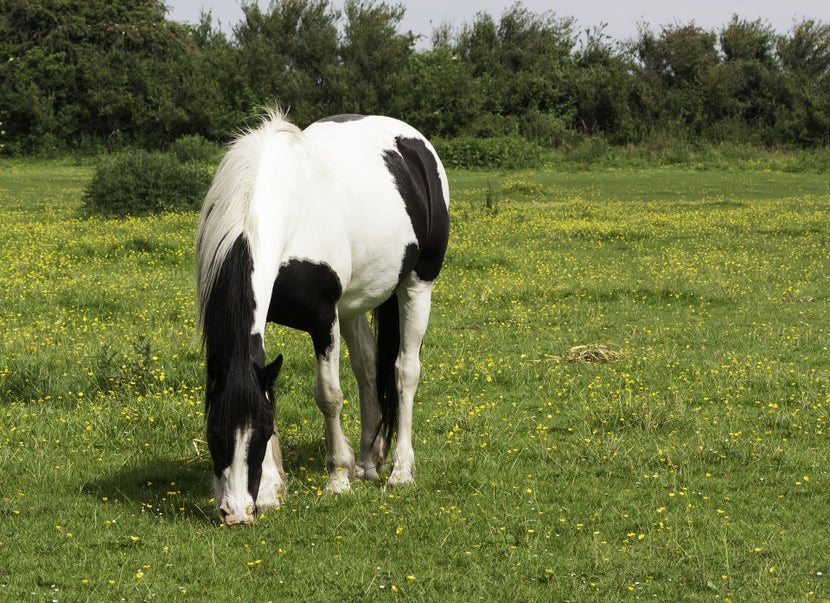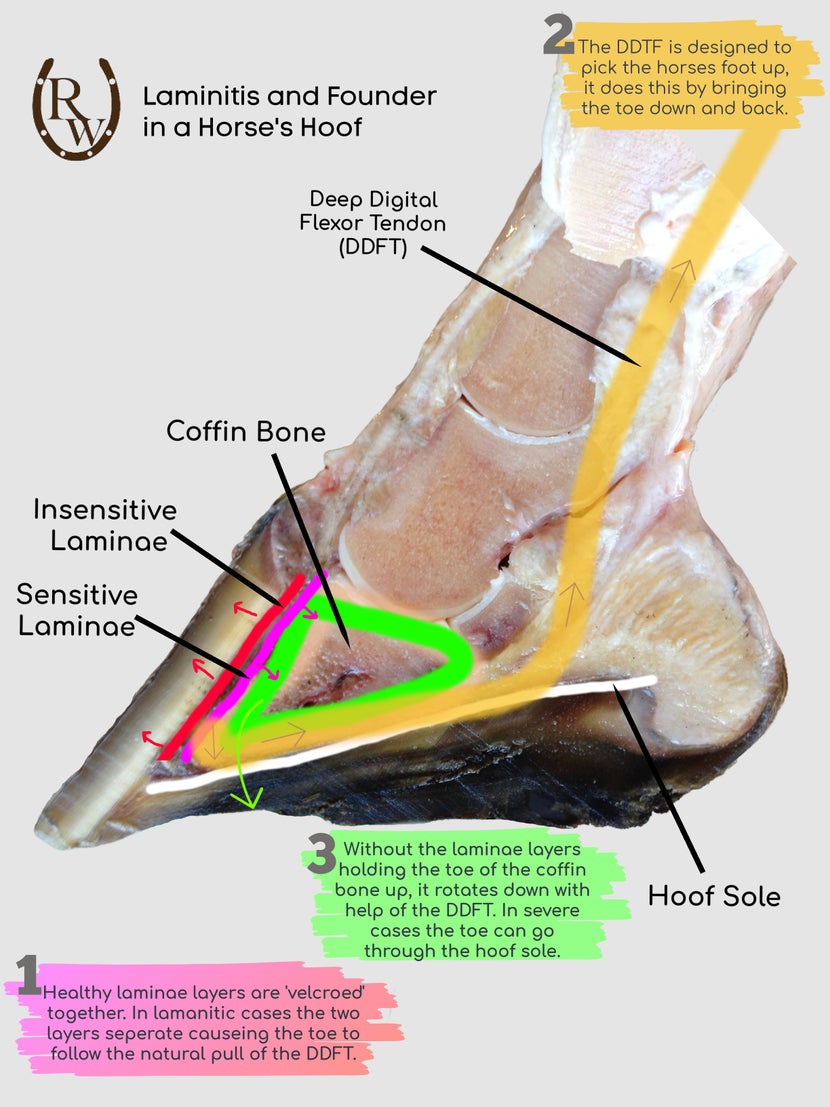Preventing & Treating
Laminitis in Ponies

Whenever our horses have an issue, it truly weighs heavily on our hearts. They are our riding partners, but more than that, they're our best friends—so no matter the ailment, we want to do our best to help them recover. The terms "laminitis" and "founder" are scary in the equine world, many equestrians know the words but don't actually know what they entail. Laminitis and founder are centered in the horse's hooves, and healthy hooves are needed to comfortably balance the horse's weight and move freely.
Similar yet different, laminitis is an acute version while founder is a chronic version of the same condition: a painful separation of the hoof laminae that can cause the coffin bone to rotate and drop. For further information on this pathology problem (among others), we highly suggest you check out our article on treating and preventing horse hoof problems. In that article, our equine experts go over the prevention, causes, and treatments of the most common and most harmful hoof health issues.
In this guide, we partnered with RW-sponsored rider Meghan Benge to address her experience with laminitis in one of her own ponies. Ponies are considered to be at higher risk for laminitis, as they tend to be more insulin resistant—especially when overweight. Being a para-dressage rider who exclusively rides ponies, Meghan knows what it is like to deal with this issue. Follow along as she offers insight from her personal journey on preventing and treating laminitis in ponies!
Preventing & Treating Laminitis

Prevention
The best way to deal with laminitis is to prevent it. Laminitis research indicates that the vast majority of cases occur in horses who are overweight or diagnosed with either EMS or PPID (endocrine disorders). Speak with your vet about whether your equine is at risk for either condition. It may be worth testing your horse for either insulin resistance or PPID to get a baseline. Also, work with your farrier to ensure your horse has appropriate hoof care.
|
Good To Know!
|
Recognize that not every case of laminitis is the severe version where the horse is suddenly unable to bear weight. Many cases begin with subtle signs such as not wanting to stand to have their hooves cleaned, reluctance to turn, or heat around their coronet bands.
The first time my para-dressage and driving pony had a bout of laminitis, she was not noticeably lame, but the evidence was there in her feet the next time the farrier visited. She had just shown in an FEI-level driving show two weeks prior and was fit enough to do a full driving cross-country course. Zoey didn't test positive for PPID until years later. After that point, we had to be vigilant with all of her care and feeding, as she was far more sensitive after that first incident than prior to it.
Also consider your horse's unique personality. Zoey is a willing pony who wants to please and seems to have a high tolerance for pain. I always know that if something seems wrong, it probably is (even if it's barely noticeable).
Diet
Diet is critical for overweight or laminitis-prone horses. Be aware there is no standardization of low starch amongst feed producers. As a result, the bag being labeled "low starch" means almost nothing. Verify the starch levels are below 10% or so with a hay analysis, and consider whether your horse even needs grain. Many laminitic equines do well on grass hay with low starches and sugars, as well as a ration balancer or vitamin supplement. Many people also report good results using a supplement such as Remission or Quiessence.
Consider also your horse's hay intake. Ideally, a horse should be eating all of the time, but many overweight horses can't safely do so. There are a number of slow-feed hay nets available to help slow down even the quickest eaters. I have also had success with a hay ball that encourages horses to move around while eating.
My ponies would say not to forget the most important thing: treats! There are a number of low-starch treats available. My ponies are partial to Buckeye's low-starch treats, particularly the carrot flavor.
Exercise
Perhaps to my ponies' dismay, exercise for overweight or laminitis-prone horses is also important. Regular exercise will make them more sensitive to insulin and help them maintain a healthy weight. Work with your vet to develop a reasonable exercise plan for your horse if you don't have one already.
Treatment
If you suspect your horse has laminitis, you should consider it an emergency and call your vet. Your vet will help develop a specific treatment plan for your horse. These treatments may include icing the feet, various medications, and stall rest. It is also important that your farrier and vet are willing to collaborate on your horse's care.
Frequently Asked Questions
Q: What are the best horse hoof boots for laminitis?
A: Laminitis can be quite painful, and cushioning the hooves where necessary with therapeutic pads can make your horse more comfortable. The EasyCare Easyboot Cloud Therapeutic Hoof Boot is recommended for a variety of hoof issues but is particularly suited for laminitis and founder cases. Laminitic hooves are sensitive hooves, and the Cloud boots cushion while absorbing concussion and lessening fatigue. Always work with your vet and farrier regarding the treatment of your laminitic horse to determine whether to use therapeutic hoof boots.
Q: What is the hoof wall separation that happens in laminitic horses?
A: Laminitis is a painful separation of layers within the horse's hoof. In a healthy hoof, the coffin bone is connected to the hoof wall via the laminae layers. There are two layers of laminae: the sensitive laminae which is connected to the coffin bone, and the non-sensitive laminae which is connected to the hoof wall. The laminae layers are "Velcroed" together but can become un-Velcroed from laminitis or foundering. When the layers become separated, the coffin bone is at risk of rotation, which drops the front of the bone down and potentially through the sole. For a more in-depth explanation of laminitis and foundering, as well as other common hoof health issues check out our Hoof Health Problems: Treatment and Prevention article.

Closing Thoughts
Treating a laminitic pony or horse can be quite stressful. Learning about the issue and understanding how to battle it through diet, exercise, and more will help both you and your equines in the long run! We're happy to help answer any questions you may have to the best of our ability at info@ridingwarehouse.com or 1-800-620-9145, but we do highly recommend seeking professional help by speaking with your vet and farrier about laminitis or founder. Happy riding!

Further Reading
We understand that you may want to do more research on hoof health and related conditions. That's why we compiled some great sources so that you can take a deeper dive!
- Michigan State University on Equine Metabolic Syndrome
- Michigan State University on PPID/Cushing's Disease
- Purina Mills on Hoof Growth and Nutrition
- University of Missouri on Functional Hoof Anatomy
- University of Missouri All Equine Related Publications
- American Association of Equine Practitioners on Laminitis and Founder
- American Association of Equine Practitioners on General Veterinary Care
- American Farriers Association Insights, Information, Farrier Locator
- Stable Horse Training on Hoof Rings and Laminitic Rings